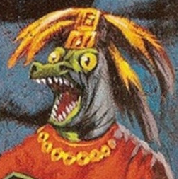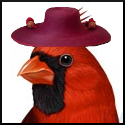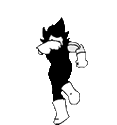|
We used to have a thread here for this sort of stuff, but it fell off the forums a while back and since no one bothered to make a replacement I figured that I would. Given that in general traditional games players like to tinker with and customize their games (as evidenced by the large selection of game design threads on this subforum) I thought it could be fun to have a new thread where we can post up ideas for the Fluff side of roleplaying as well as the Crunch. Traditionally its up to the GM to do the heavy lifting when it comes to setting design (though there are games where its more of a collaborative effort), which always made it feel like a single player side-game bolted onto the meat of the actual roleplaying session itself and its been one that I admit to finding pretty fun in the past. So if anyone has ideas for their setting that they'd want advice or critique on, or just if you just feel like sharing if you think its especially cool or whatever, then feel free to post it all here. It can be as simple as a minor change to your favorite/most hated fantasy race in a pre-made setting, to a full-blown new world complete with maps and travel brochures and poo poo - go nuts.
|
|
|
|
|

|
| # ? Apr 26, 2024 19:13 |
|
I always thought it was interesting how much Japanese swordfighting was defined by their lack of decent metal ore, so when I work on my pet setting off and on, I have a little note to expand on to include a zone with bad ore. I don't wanna just copy down everything Japan ended up with, though, but I'm also not well versed enough in blacksmithing and such to come up with a substantial list of alternative paths you could take to deal with lovely ore. Anyone have any interesting ideas or relevant expertise I could steal?
|
|
|
|
|
Heatwizard posted:I always thought it was interesting how much Japanese swordfighting was defined by their lack of decent metal ore, so when I work on my pet setting off and on, I have a little note to expand on to include a zone with bad ore. I don't wanna just copy down everything Japan ended up with, though, but I'm also not well versed enough in blacksmithing and such to come up with a substantial list of alternative paths you could take to deal with lovely ore. Anyone have any interesting ideas or relevant expertise I could steal? Lack of metallurgy gave Mesoamerica a bunch of cool weapons. Staff fighting is probably the biggest non-sword melee weapon tradition worldwide.
|
|
|
|
One thing that has always stuck in my mind ever since I first picked up a 3.0 Monster Manual was the idea of "evil" races. Why did it have to be set in stone that orcs, goblins and kobolds would always be evil, all the time? Especially since I wanted to play as those races. I mean, after all, they looked far more fantastical and cool than elves, dwarves and gnomes. So I always ignored that rule, because it seemed dumb. After all, how could every single member of a species be bad no matter what? So when I designed my own world, one of the things I wanted was "no evil races". I wanted the races to be more or less neutral, and for individuals and factions to lean one way or the other morally. But while doing so, I figured the non-monstrous races were in for an overhaul as well, to make them fit with the general vibe of the setting. Below I've listed out the major races of my campaign setting, with a brief description. Goblins: The "first" species, who developed language and civilization on a large continent. They make up the majority of the population due to their quick breeding and fifty-year lifespan. They occupy every level of society, from the highest of Guildmasters to the lowliest gutter scum. They have keen minds and a meticulous attitude, and when the average citizen thinks of the typical bureaucrat, they picture an overworked goblin. Humans: Interplanar invaders, humans followed their conquering god to this world as they had done many times before. After making rapid advances against the defending nations of the world, their god was struck down and their main forces defeated by the orcs, the humans lost their will to fight and laid down their weapons. Over time, they were integrated into the existing populace, and have grown into the second most populous species, and due to their history as a warrior race are seen as the typical soldier, mercenary or bandit. Kobolds: Adaptable and fluid beings, kobolds are easily affected by the magical energies of the world, and are more prone to mutation. Having started off as scavengers and thieves, kobolds are now considered the typical laborer and jack-of-all-trades. Due to their highly-mutable forms, their appearance ranges the gamut from reptillian to insectile, with anything being possible. Some clever kobolds have the ability to control their mutation in order to blend in with other diminutive species. Halflings: Masters of magic with devious minds, the halflings have a long and ugly history of being renowned slavers. Using their talents with magic, they spent many centuries raiding the gnolls and goblins for slaves, and even succeeded in enslaving the great animal spirits. Recently, after the defeat of their nation Rothera, they have been forced to give up this nasty tradition, and halfling emigrants are seen as potential slavers, no matter what their personal beliefs. Gnolls: Canine-like beings, able to function as both bipeds and quadrupeds, the gnolls once shared a vast expanse of rolling hills and deep forests with the halflings. The two species have been long-standing enemies, with the gnolls eventually losing the conflict and migrating away into goblin lands. Due to their inability to lie, gnolls are considered awkward at best, and mostly keep to their own kind, but their honesty is above reproach in the courts. Elves: The result of genetic experimentation on humans, the elves are a younger species. Created by scientists attempting to create the ideal human, the elves were infused with the kobolds' ability to mutate and adapt. Though less gifted than the kobolds, these escaped lab experiments have integrated with society. Their immortality lets them pursue many paths without worry, but elves are often found in the scientific fields of study, fascinated by the principles that led to their creation. Beastfolk: Encompassing a wild array of distinct species, the beastfolk are considered to be one of the older species in the world, but have long been seen as less intelligent or clever than the more developed races. The beastfolk have never had their own nation, and in fact are spread far and wide. Despite this, they occupy a variety of niches throughout the world, but most prefer to live in smaller communities, as large cities do not appeal to them. Orcs: Summoned from the mind of a goddess, the orcs were originally brought into the world to fight the humans during their invasion. Since then, the orcs have matched the humans for their versatility and drive. The thought of orcs draws to mind images of sailors, both of the seas and the skies. Whether it is shipping cargo among the clouds, fishing on the high seas or pirates preying on coastal communities, orcs are drawn to ships and the the wide-open blue. Dwarves: Wizard-lords from deep below, the dwarves arrived a millenia ago along with the gnomes. Fleeing from some indescribably horror that destroyed their civilization, the dwarves have a magical tradition that puts the most magically-capable in charge. This magocracy has not transitioned into the surface world, but dwarven colonies and clans still order themselves by most powerful mage down to those without magical talent, who are considered the lowest. They are almost never found without a population of gnomes nearby, as the two peoples have developed a deep partnership in their time together. Gnomes: Battle-hardened warriors afflicted with the taint of madness who arrived alongside the dwarves. Fighting on the frontlines against the horror from below, the gnomes have been struck with a hereditary insanity. With strange eyes that look in different directions independently and a talent with firearms and explosives, the gnomes are sought-after mercenaries and soldiers. They are also great practitioners of the applied sciences, and produce great engineers. Arthians: Relatively recent arrivals, the Arthians are a variety of insectoid species who fled a dying world by warping a continent away from the destruction. This act destroyed the goblins' homeland, and left most people distrustful of them. Despite this, the Arthians have proliferated into the world at large, trading their strange biomechanical wonders for odd things that seem to have no real value. Due to their strange appearance and odd mannerisms, most people do not know quite what to think of the Arthians. Saurid: Reptillian humanoids, the saurid hatch from eggs looking much like humans, who over their millenia-long lifespan transition fully into bipedal reptillian beings. Long ago, a tribe of humans came across a crashed interplanar ship deep in the desert. There, they were affected by the artificial being onboard, who infused the tribe with the blood of the dead reptillian creatures who had died in the crash, giving birth to the Saurid. Over time, they become cold-blooded and more lethargic. Known for their regenerative abilities, Saurid are typical explorers and risk-takers, given their ability to recover from almost any wound. Autons: A wholly artificial race, the autons are machines with a dizzying array of appearances. Though they are able to think, they are not magical in any way, which has long puzzled generations of engineers and scientists. Even more aloof than the Arthians, these machine-people are seen doing many jobs, and are renowned for their ability to change and modify themselves, creating a vast array of things that they can do. The Autons themselves attempt to be as unobtrusive as possible, but are often prone to fits of passion and obsession, modifying themselves for some purpose, only to abandon it later for another. I've also provided for other races, like tieflings and aasimar and other, weirder things like the gensai. If a player wants to play something not on here, I'm always up for finding a way to incorporate it.
|
|
|
Serf posted:One thing that has always stuck in my mind ever since I first picked up a 3.0 Monster Manual was the idea of "evil" races. Why did it have to be set in stone that orcs, goblins and kobolds would always be evil, all the time? Especially since I wanted to play as those races. I mean, after all, they looked far more fantastical and cool than elves, dwarves and gnomes. So I always ignored that rule, because it seemed dumb. After all, how could every single member of a species be bad no matter what? This is a pretty cool take on things - I never liked the "always evil" species concept myself either. People don't have to be born straight out of the womb with glowing red eyes, twirling their tiny mustaches to make good villains. You can definitely have evil and hosed up individuals, but usually I think it would all come down to conflicts of interests/clash of cultures. From the Aztec priests perspective ripping out your heart and rolling your severed head down the steps of the pyramid is a supremely good act since its the only thing keeping the sun in the sky and preventing the fickle gods from exterminating mankind like they have done many times in the past. From your perspective as the next guy in line to get the obsidian knife treatment its a whole different story.
|
|
|
|
|
Me and some friends have this Pathfinder game going and since it was open setting and all that got to have a bit of fun religions and meddling with establishing culture and setting. So going with a dwarf here so the first thing I loathed about D&D dwarves is the whole grumpy dour unpleasant lack of charisma-ish of them. I mean seriously why would they do that? These are a group drawn from Tolkein inspiration. These are people with a storied past, who remember their ancient legacies and legends in song. Dwarves are a race as passionate as the fires that burn deep underground. So first took the whole bard idea to twist it into this perspective. The lorekeeper, the Skald, the dwarf who remembers the ancient songs and legends, whose voice hammers out not only the beats of work but the beats of war. That all done the next thing was to play around with other typical things and see ways they could go. Well obviously dwarves have this big earth thing...but that doesn't have to be the heart of their faith or beliefs. I went with their primary faith being centered around the Air. Air, the source of life for those underground. Borrowing a bit from other games included the idea of the soul entering with first breath, the dead don't breath, underground bad air will kill more surely and silently, a few things like that. It wasn't about just ignoring things but looking at ways they could favor other things and for it to make sense. So by the time I got around to my actual character I had a dwarven womanizing bard who worshiped four elemental deities with their primary one being the Air spirit. Actually was quite a fun little bit of world building.
|
|
|
|

|
| # ? Apr 26, 2024 19:13 |
|
In my campaign world, I've been working on the idea of the elements that make up existence. Some of them exist as a scale like Heat/Cold others have an inverse like Air/Void or Life/Death. Some, like Electricity, Sonic, Gravity and Metal don't have an opposite or inverse. But the one pairing I want to talk about is Light/Dark. See, in my experience Light = Good and Dark = Evil. But I don't really find good and evil to be an interesting concept and I stay away from it. I prefer ambiguity and shades of gray. So I had to come up with a different dichotomy to define the relationship between Light/Dark and how they are interpreted by the world. I feel like since most of the sentient beings in my world are diurnal, Light would be considered a generally positive thing since it reveals things around them and lets them see. Dark keeps things hidden and obscures the truth. Truth was the fundamental concept that I came to base Light/Dark around. Light is all about revelation and understanding. Light shines on something and it becomes known, and in time understood. Dark is about secrets and ignorance, keeping the truth from people. At first I thought this was just good and evil just rephrased. After all, we do consider knowing and understanding good and ignorance to be, if not evil, at least bad. But then I thought about the sort of things that inhabit my world, like the Cthuloid horrors deep down below, the hungering fae in their immaterial realm, the demonic hordes just on the other side of reality and all the intrigue that keeps the world running. There are some things people are better off not knowing about. So in this sense, Light does bring knowledge and understanding, but it is indiscriminate. It brings new things to light that help people, but also can reveal secrets that are dangerous. Knowledge is good, but it is also powerful, and can be used for the wrong reasons. Dark seeks to keep things from being known, and would have the whole world ignorant if it could. But it is right in some cases. A secret that could topple an empire and kill millions in war should be kept buried, and agents of Darkness work to see that it is never revealed. In this way, the conflict between Light and Dark isn't about good and evil, since there are examples of both concepts to be found on both sides of the spectrum. In general, Light is still more positive than Dark, but both have their failings. Setting Example: One of the major factions in my game is the Seekers. They are devotees of the god of knowledge, Khaldun. They seek out knowledge from ages past and collect it for dissemination via books, newspaper and radio. They fund mages and scientists alike to explore the inner workings of the universe. Above all else they believe that information should be free and available to all who seek it. But within them, there is a Dark cult, the Maloi. These cultists work from within the Seekers, and many of them consider themselves to be faithful to Khaldun. But their philosophy differs from their god's in that they do not think all things should be known. Some believe that a Dark facet of Khaldun calls out to them to bury the most heinous and dangerous of secrets for the good of all people. Maloi are on the frontlines of the Seekers' work, out retrieving old books and collecting accounts and items from ancient ruins. Most of it is passed along for processing, but when a Maloi cultist comes across something truly dangerous, they conceal it. They hide it away or destroy it if they can, and will use any measures necessary to preserve its secrecy, including murder. No one knows how far up this conspiracy goes, but a few Seekers do know of their existence. The Maloi, in various incarnations, have been destroyed by the Seekers no less than four times. But they always come back. In each case, it was their destroyers who turned to carry on their work. In each case, those who hunted the Maloi down kept it a secret, to prevent damage to the image of the Seekers. In the end that secret is what consumed them, and in each case those Seekers found that they had become Maloi unconsciously, and slowly the cult was rebuilt by those who had killed it.
|
|
|










